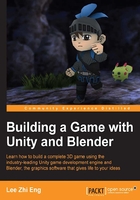
The characters concept
The characters concept usually refers to the concept arts, which display the design of your game characters. Concept artists have to come out with dozens of sketches and color thumbnails before a final design is selected by the art director. Once the character concept is confirmed and finalized, 3D artists start working on the 3D models by referring to the concept arts provided for them.
It's not as difficult as you think to design a character from scratch. Make sure that you truly understand the game you're trying to make. If you don't, try to read through the GDD and the storyline repeatedly until you are very familiar with each character's background story, personality, and their roles in the game. Once you're familiar with the game characters, try to imagine how they should look like in the visual style you chose earlier.
When designing characters, it's best to start with the silhouette. Try to define the character's personality using only the silhouette and ignore all other forms of details. We don't need to worry about the color, texture, facial expression, clothing, accessory, and anything else at this stage. Focus only on the body shape, size, contour, and posture that can easily make a player recognize the character and be able to tell the roles of the characters by simply judging from its outlook.
I prepared an image showing three characters' silhouettes. Try to guess what their personality is by judging from their respective silhouette.

Let's take a closer look at this diagram:
- Character A: The first character looks small, cute, and vulnerable. He is probably harmless to you, don't you think so?
- Character B: The second character looks like an ordinary person, but his uneasy posture infers that he could be a sly character with bad intention. Better not to get too close to him.
- Character C: The third character looks extremely dangerous even from afar! Does he bite? I'm sure he does more than that!
Once you have chosen the silhouette of each character, you can now start adding detail! However, no color should be used at this stage. Use only lines to sketch out the appearance of the characters. Concept sketches should be fast, and it's okay for the sketches to look messy at this stage because we want our brain to continuously come out with different ideas without being distracted by small details. Don't be afraid to experiment with different ideas you have, you might be surprised how creative you could be!
After you've done a dozen or so rough sketches, pick one that you think most suitable for your game. Redraw the characters with fine lines and make sure that they look clean this time because we are going to put some colors on it!
The following image shows the sample characters' concept that I used for this book. I have chosen a more manga-ish, chibi style for my game characters. I skipped the silhouette and rough-sketching steps because well, the game demo I'm showing in this book is just a very, very simple game, so it's exceptional.

Now, let's take a closer look:
- Character A: Block out the character with simple shapes, only simple shapes!
- Character B: Start adding detail.
- Character C: Clean-up and finishing.
After you have done all the clean-up jobs, we will proceed to the next stage, which is adding colors to your characters! Use only plain colors to fill in the design at this moment. No lighting or shadow should be allowed because again, we want to focus on experimenting different sets of color pallets on our characters and not be distracted by elements.
Note
Be cautious when deciding the color palette for your characters. Choosing the wrong color could influence your player's interpretation toward your character's personality and role. Wrong color could also affect the visual focus of your character, making it hard to be seen on the screen (for example, a green character standing on a grass field).
Here, I experimented with three different colors on my character. I picked the one that, in my opinion, resembles his personality:

- Character A: Although red color looks really nice on him, it looks way too aggressive and that doesn't suit my faint-hearted character.
- Character B: Blue color looks more calm and friendly, which is suitable for my character.
- Character C: Totally, not my cup of tea.
The same method is used for the monster design as well. Eventually, I picked the one with red/pink patterns on its body. The color is more aggressive and at the same time contradicts with the main character's color. Also, warm colors, such as red or orange, often represent caution or danger. In order to speed up the process, I will just pick monster C as the final boss.

Finally, create a scale comparison chart to let everyone in your team know exactly how big or small should the characters look like. This information is extremely important for the 3D artists as well as gameplay designer. Make sure that everyone in your team is aware of this chart.
